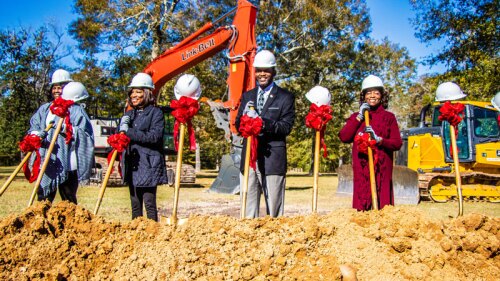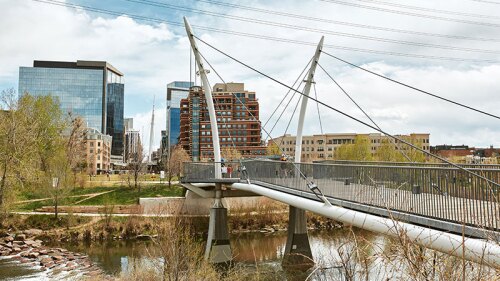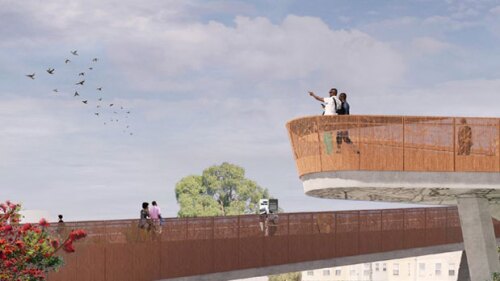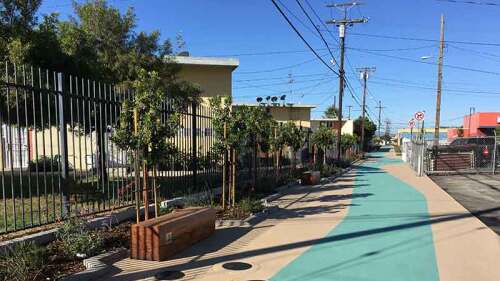| Birmingham’s Railroad Park opened in 2010 alongthe rail line that was built in the late 1800s,during the city’s industrial heyday. |
A river of steel delivers new life to Birmingham, Alabama
For decades, waterfronts have served as a catalyst for revitalization in downtowns across the continent. From Chattanooga, Tennessee, to Vancouver, British Columbia, the promise of developing public areas near these attractive settings has proved successful. But what about cities that are not located on a river, a lake, or an ocean? Where does revitalization start for them?
Birmingham, Alabama, has taken a unique approach to redevelop its core. Using the industry on which the city was built and its abundant natural resources, the city has developed Railroad Park, a 19-acre (7.7 ha) greenway connecting downtown Birmingham with the region’s major employer and one of the nation’s leading research institutions, the University of Alabama at Birmingham (UAB). In short, Birmingham is using its past to build its future.
Downtown Birmingham’s railroad system, built during the late 1800s, is a major artery for industry, helping make the city the foundry-iron capital of the world at that time and the economic engine of Alabama today. The city’s proximity to all the major elements needed for iron and steel production and the area’s subsequent growth helped give Birmingham its nickname, the Magic City. The rail line has essentially been treated as a river, with downtown bridges passing over the tracks the way Chicago, Pittsburgh, and Lansing, Michigan, built bridges across their waterways.
| Railroad Park offers foot paths, a skate park, ponds,and open green space. |
In recent years, local officials renewed efforts to revive the city center and bring together downtown and the ever-expanding UAB. Embracing the railroad seemed an odd choice at first, but making it a focal point of revitalization efforts—rather than burying it, as other cities had done—provided a clear path forward.
The $17.5 million Railroad Park, opened in 2010 and designed by Berkeley, California–based landscape architect Tom Leader, is the second phase in what is planned as a string of green-space projects throughout Birmingham, intended eventually to give Birmingham more green space per capita than any other city in the country.
The park borders the historic railroad lines, uniting the two sides of downtown physically and, more important, socioeconomically. It has become a meeting space for city residents of various backgrounds and sparked a series of new projects in and around the area bordering the park, prompting optimism for future development.
Evidence of that is a new $64 million baseball stadium for the Birmingham Barons Double-A minor league baseball team, which broke ground in February adjacent to the park. This followed the completion of Cityville Block 121, a $35 million luxury residential complex one block away with 255 apartment units and 21,000 square feet (2,000 sq m) of retail space. It was completed two months before the park’s opening in 2010.
Near the park, anticipation has grown around a proposed entertainment district, and a $4 million renovation of the National Biscuit Co. building for use as office and retail space is underway.
| City leaders chose not to hide views of ongoingrailway operations, but instead embraced thetrains as a reminder of the city’s history. |
Also proposed is One Birmingham Place, a multiuse facility intended to foster community collaboration and create a vibrant sense of place downtown on an empty city-owned block adjacent to the park. The concept for the project—proposed by local development consultant Colin Coyne to incorporate performance, social media, visual arts, community theater, and community organizations—was selected from among more than 1,000 entries in a contest held by the Community Foundation of Greater Birmingham.
Efforts are ongoing to connect the park by shuttle bus to a separate entertainment district and a new $70 million Westin hotel being built at the Birmingham-Jefferson Convention Complex, eight blocks to the north. The 300-room hotel is projected to open in January 2013, followed in a few months by a 60,000-square-foot (5,600 sq m) entertainment component for retail and restaurants.
All this development stems from a park that once housed a warehouse and a brick-making facility. The new terrain consists of footpaths, ponds, open green space, plazas, and a skate park, all providing framed views of downtown, as well as of passing trains.
| Railroad Park offers foot paths andopen green space. |
Though Leader’s firm had provided the larger design and ultimate concept for the park, it was Birmingham city leaders who initially pushed for the park not to hide the railroad tracks, but instead embrace them as a reminder of what led to the formation of Birmingham. The park is constructed from elements unearthed from the site, including bricks and cobblestones from early Birmingham industrial development along the tracks.
Railroad Park is the cornerstone of a larger park system within the city limits that includes 1,100-acre (400 ha) Ruffner Mountain Park seven miles (11 km) to the northeast and the proposed 1,200-acre (500 ha) Red Mountain Park, the same distance to the southwest. The latter two are both former iron-ore mining sites that have been the focus of reclamation projects.
The projects in Birmingham prove that a city does not need a waterfront to be beautiful or to experience a revival. Cities looking for a renaissance can find a catalyst inland just as cities along a coast can base their resurgence on the water. And cities that have already built out their waterfronts should consider resources with unrealized potential for that next phase of urban rebirth. As is the case in Birmingham, doing so can make a onetime Magic City magic once again.








